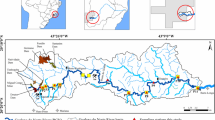Abstract
Bottom sediments in rivers and water bodies represent an important accumulation component of water systems. The technogenic alluvial sediments are formed in stream channels under the ever-increasing technogenic impact; they are characterized by a specific material and geochemical composition.
Similar content being viewed by others
References
A. I. Achkasov, Trace Element Distribution in Agricultural Landscapes of the Moscow Region, Extended Abstract of Candidate’s Dissertation in Geography (IMGRE, Moscow, 1987) [in Russian].
A. A. Volokh, A. A. Kolesov, and A. E. Chernova, “Determination of Mercury Thermoforms with an Atomic Absorption Method,” in Geochemical Investigations of Urban Agglomerations (IMGRE, Moscow, 1998) [in Russian].
S. V. Efremova and K. G. Stafeev, Petrochemical Methods of Investigations of Mountain Rocks (Nedra, Moscow, 1985) [in Russian].
Yu. D. Zherebtsov, M. I. Politkov, and V. Yu. Sikorskii, Technology of Mercury-metric Prospecting of Ore Deposits, Ed. by F. P. Fedorchuk (Nedra, Moscow, 1992) [in Russian].
V. G. Kazak and A. I. Angelov, “Estimate of the Content of Environmentally Controlled Pollutants in the Phosphate Raw and in Phosphor-bearing Fertilizers,” Khimicheskaya Promyshlennost’, No. 11 (1999) [Chemical Industry, No. 11 (1999)].
M. A. Karasik, S. I. Kirikilitsa, and L. I. Gerasimova, Atmogeochemical Methods of Ore Deposit Prospecting (Nedra, Moscow, 1986) [in Russian].
R. Ler, Processing and Use of Agricultural Wastes (Kolos, Moscow, 1979) [Russian transl.].
A. P. Novokreshchenov and A. A. Volokh, “Possible Application of a Method for Determining Mercury Thermoforms in Ecological Monitoring,” in Ecogeochemical Problems of Mercury (IMGRE, Moscow, 2000) [in Russian].
N. I. Razenkova and A. A. Volokh, “Species and Forms of Mercury in Natural and Anthropogenic Objects,” in Ecogeochemical Problems of Mercury (IMGRE, Moscow, 2000) [in Russian].
Yu. E. Saet, Anthropogenic Geochemical Anomalies (Peculiarities, Methodology of Studying, and Environmental Value), Extended Abstract of Doctoral Dissertation in Geology and Mineralogy (IMGRE, Moscow, 1982) [in Russian].
N. Ya. Trefilova and A. I. Achkasov, “Biogeochemical Consequences of Application of Organic Fertilizers,” in Biogeochemical Methods in Studying the Environment (IMGRE, Moscow, 1989) [in Russian].
E. P. Yanin, Technogenic Geochemical Associations in Small River Bottom Sediments (Composition, Peculiarities, Estimation Methods) (IMGRE, Moscow, 2002) [in Russian].
E. P. Yanin, Technogenic River Sludge in the Zone of the Industrial City Influence (Formation, Composition, Geochemical Peculiarities) (IMGRE, Moscow, 2002) [in Russian].
Author information
Authors and Affiliations
Additional information
Original Russian Text © G.G. Akhtyamova, 2009, published in Meteorologiya i Gidrologiya, 2009, No. 2, pp. 80–88.
About this article
Cite this article
Akhtyamova, G.G. Anthropogenic transformation of the bottom sediments composition in the Pakhra River Basin (the Moscow Region). Russ. Meteorol. Hydrol. 34, 118–124 (2009). https://doi.org/10.3103/S1068373909020083
Received:
Published:
Issue Date:
DOI: https://doi.org/10.3103/S1068373909020083



